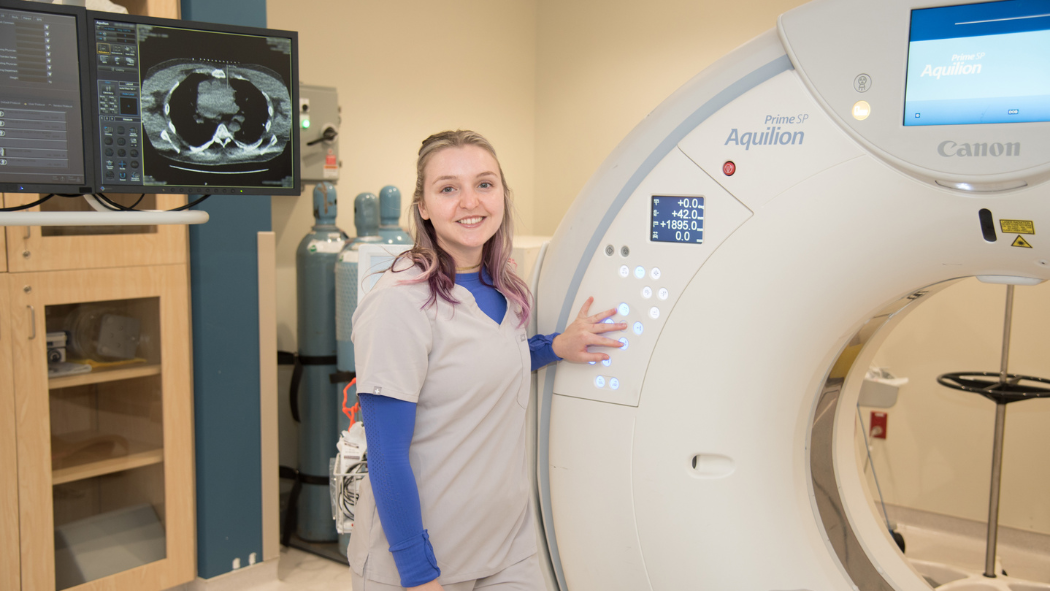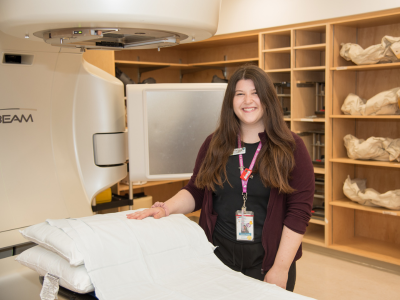
November 6, 2023
Medical Radiation and Imaging Technologist Week is an opportunity to hear from team members who provide imaging, intervention and therapy to patients at LHSC about the work they do and the care they provide. Medical Radiation and Imaging Technologist work throughout University and Victoria Hospitals in various areas:
- Computed Tomography (CT)
- Medical Resonance Imaging (MRI)
- X-Ray
- Nuclear Medicine, also known as Molecular Imaging and Theranostics
- Interventional Radiology and
- Ultrasound
- Cardiac Catheterization Labs
- Radiation Therapy
What inspired you to pursue a career as a Medical Radiation Technologist (MRT)?

Paige Seguin, MRT (R) - VH CT
I was inspired to become a MRT by my Chiropractor. After taking an x-ray of my spine, she reviewed my anatomy with me. I thought that was one of the coolest things I had ever seen! Previous to this experience, I had never broken a bone or needed an x-ray before, so was not aware that this was a career option that would pique my interest. I have always been fascinated by health sciences, and I was (and still am!) and happy to have gone to school to become an MRT.
The journey from starting in General Radiation in Kingston to advancing my expertise and working in Computed Tomography (CT) at LHSC has been very fulfilling. I would recommend becoming an MRT to anyone who has an interest in health sciences, there are many avenues to choose from and everyday you learn something new.

Argentina "Tina" Zeledon, MRT (R)(MR) - VH X-Ray
Helping others, providing care and guidance to anyone in a time of need has always been my inspiration leading to health care. This coupled with my admiration and understanding of science and technology, led me to my career as a Medical Radiation Technologist (MRT). Working as a MRT is extremely rewarding, I have the privilege of providing care to patients and operating new innovative technologies.
In this roll, I've been able to expand my skill sets, including advanced practices in Fluoroscopy, operating portable CT in the operating room, and portable imaging. Advances in electronics and software in imaging have improved our ability to provide diagnostic information not previously achievable. In seven short years I have outgrown the original vision of myself from when I first began my career, and with no limits in sight, I am planning to move into Magnetic Resonance Imaging (MRI). I am grateful to be a part of the Medical Radiation Sciences team here at LHSC.
Can you share a specific experience or moment that solidified your passion for being a MRT?

Cathy Partridge, MRT (R)(MR) - UH MRI
I remember early in my career scanning an elderly patient for his spine as he had lost movement in his legs.
There was a large abdominal mass they were aware of, but did not know if this was causing the issues with his spine, or if there was something else going on. From the MRI imaging it was determined that the mass they saw in his abdomen was actually an aortic aneurysm and it had pushed into a vertebra fracturing it. The vertebra bone fragments were pressing into the spinal cord leading to the loss of movement in his legs. The imaging we were able to provide changed the treatment for this patient. He did not need to have the mass in his abdomen biopsied, and he received the proper treatment.

Danielle Duncan, DMS - VH Ultrasound
I truly value being in a position where I can positively impact the lives of patients I cross paths with each and every day. It may be as simple as offering a friendly hello and smile before a nerve-racking test or contributing information that can lead to a diagnosis and potential treatment that may save someone's life. Regardless, I aim to leave someone's day a little brighter than I found it.
How do you envision making a meaningful impact on patients' lives as a MRT?

Elizabeth Cesarin, MRT (R) - UH IR
As a MRT I do my best to make impact on my patients lives every day. I work in a procedure area. Most patients are nervous and often afraid of what is to come in the next few minutes, and also about the future with the status of their health. I make it a priority to make them feel comfortable. I try to put their mind at ease about the procedure. I will often talk to them about things that may lighten the mood such as their families, kids, grandchildren, careers, hobbies, and even share a story about the joys in my life to help take their mind off the task at hand. I feel a smile and a positive attitude goes a long way and leaves a lasting impression on my patient’s experience.

Sophia Provencal, MRT (T) - LRCP Radiation Therapy
As Radiation Therapists, we administer targeted doses of radiation, verify treatment plans and provide education on potential side effects, however our role extends far beyond the technical aspects of radiation treatment.
Our role as MRTs is to approach patient care with compassion and empathy and recognize that a cancer diagnosis can be emotionally and physically overwhelming. The length of treatment regimens allows us to form connections and recognize changes in a patients' mood or physical well-being. We strive to highlight celebratory moments like birthdays or anniversaries, play patients' favourite songs, or offer a listening ear to create a comforting environment where patients feel valued and understood.
My vision of patient care centers around not only delivering precise radiation but offering a kind and reassuring presence. Our goal is to ensure patients don't feel like they're going through this alone; which I feel makes the most meaningful impact on our patients' journey.
What aspect of your work as an MRT do you find most rewarding, and why?

Serena Swan, MRT (R) - Cardiac Catheterization Labs
I have always found great joy in my role as a Medical Radiation Technologist (MRT), but there is something special and exceptionally rewarding about working in the Cardiac Catheterization Lab (CCL).
Working in this unit allows me to witness first-hand the incredible transformation that patients undergo within a matter of hours. It's truly remarkable to see individuals who were experiencing heart attacks, quickly regain their health and well-being. The gratification that comes from being part of this team is immeasurable. Our work in the CCL is often measured in minutes. Witnessing these rapid changes and knowing that our team's efforts directly contribute to saving lives is both humbling and inspiring.
I have the privilege of working alongside a dedicated team of health-care professionals who share the same passion for making a difference in people's lives. This collaborative environment fosters growth, learning, and continuous improvement, allowing us to provide even better care for our patients.

Christine Brooks, MRT (NM) - UH Nuclear Medicine (also known as Molecular Imaging & Theranostics)
What I find most rewarding of my work as an MRT is being able to help find answers for patients who have been suffering for so long. We often get patients in Nuclear Medicine who have gone through so many diagnostic tests, trying to find the source of their symptoms and pain. When our imaging modality can find their diagnosis and allow the teams to create the proper treatment plans, it is so rewarding.